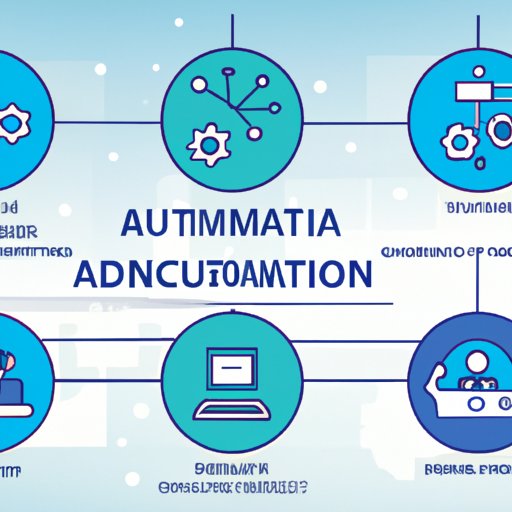Introduction
Digital automation is a term used to describe the process of automating tasks that are traditionally done manually or with minimal computer assistance. It is a form of technology that enables machines to carry out complex tasks without any human intervention, resulting in improved efficiency and productivity. Digital automation has become increasingly popular in recent years as businesses recognize the potential of this technology to increase their efficiency and reduce costs.
A Guide to Understanding Digital Automation
To better understand digital automation, it is important to consider the different types and how they work. There are two primary types of digital automation: rule-based and artificial intelligence (AI). Rule-based automation involves using software to automate tasks based on predefined rules and parameters. AI-based automation uses machine learning algorithms to identify patterns and make decisions without human input.
Rule-based automation can be used for a wide range of tasks, including data entry, customer service, and scheduling. AI-based automation is more complex and can be used for more sophisticated tasks such as natural language processing and image recognition. With both types of automation, businesses can benefit from increased efficiency, accuracy, and cost savings.
Benefits and Challenges of Digital Automation
The primary benefit of digital automation is increased efficiency. By automating mundane and repetitive tasks, businesses can free up resources and personnel to focus on more important activities. Additionally, digital automation can reduce errors and improve accuracy by eliminating human error. Automated tasks also tend to be faster and more reliable than manual processes, resulting in improved customer satisfaction.
Despite these benefits, digital automation does come with some challenges. For example, there is a risk of introducing bugs and errors into automated systems. Additionally, digital automation requires significant upfront investment, which can be cost prohibitive for some businesses. Finally, digital automation may require specialized skills and knowledge to set up and maintain.

The Future of Digital Automation
As digital automation continues to evolve, businesses are increasingly turning to automation to streamline their operations. Automating the digital workplace will allow organizations to reduce costs and improve efficiency by eliminating manual processes and replacing them with automated ones. Additionally, businesses will be able to increase their agility and responsiveness by leveraging automated processes.
Digital automation is also having a major impact on businesses. Automation can help reduce costs and improve efficiency by streamlining processes and eliminating manual labor. Additionally, it can help businesses increase their agility and responsiveness by enabling them to quickly respond to changing customer needs and market conditions.

The Impact of Digital Automation on Businesses
Businesses are increasingly leveraging digital automation to streamline their processes and improve efficiency. Automation can help reduce costs by eliminating manual labor and streamlining processes. Additionally, it can help businesses increase their efficiency and productivity by automating mundane and repetitive tasks. Furthermore, digital automation can help improve customer satisfaction by reducing errors and improving accuracy.
Digital automation can also help businesses gain access to new data sources, which can be leveraged to gain insights and make informed decisions. Additionally, automation can help increase security by monitoring and detecting anomalies in networks and systems. Finally, automation can help businesses develop new technologies, such as robotics and autonomous vehicles, which can revolutionize their operations.

How Digital Automation Is Changing the World
Digital automation is transforming the way businesses operate and how people interact with technology. Automation is making data more accessible, allowing businesses to gain insights and make informed decisions. Additionally, automation is improving security by monitoring and detecting anomalies in networks and systems. Finally, automation is enabling the development of new technologies, such as robotics and autonomous vehicles, which have the potential to revolutionize the way we live and work.
Conclusion
Digital automation is a powerful tool that can help businesses streamline processes, increase efficiency, and reduce costs. Additionally, digital automation can help businesses gain access to new data sources, improve security, and develop new technologies. As digital automation continues to evolve, it will continue to shape the way businesses operate and how people interact with technology. The key is for businesses to recognize the potential of digital automation and leverage it to take advantage of its many benefits.
(Note: Is this article not meeting your expectations? Do you have knowledge or insights to share? Unlock new opportunities and expand your reach by joining our authors team. Click Registration to join us and share your expertise with our readers.)
